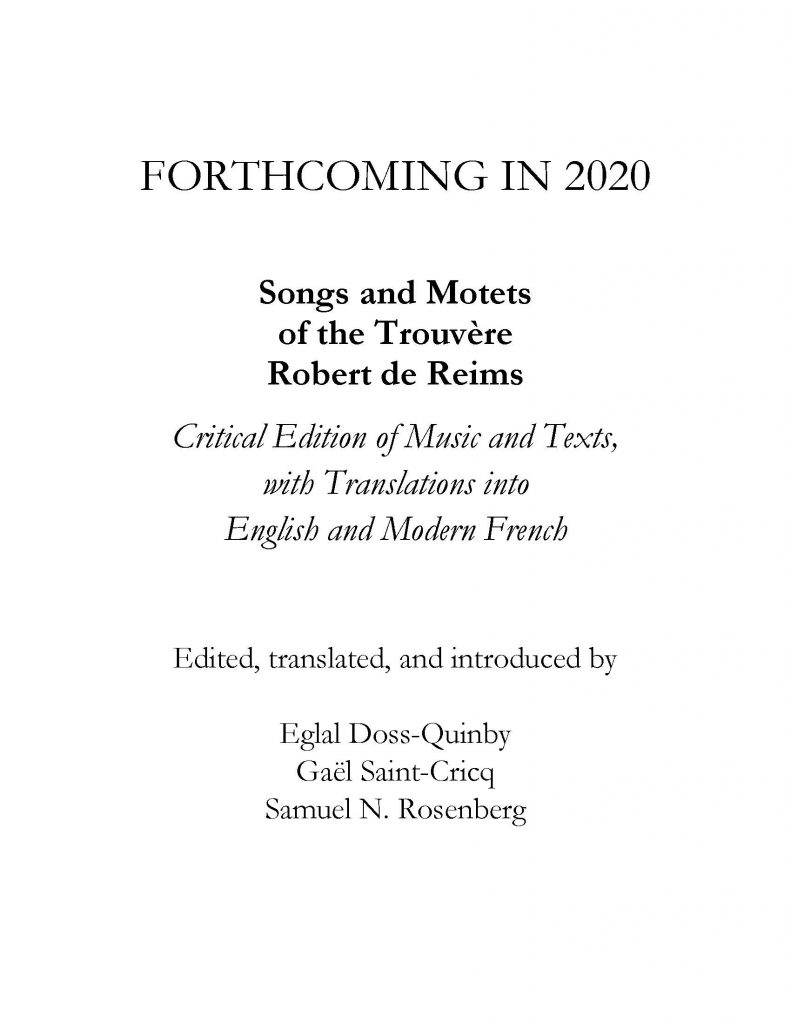
- Edited, translated, and introduced by Eglal Doss-Quinby, Gaël Saint-Cricq, and Samuel N. Rosenberg
- University Park, PA: Pennsylvania State University Press, forthcoming in 2020
- ISBN forthcoming
Robert de Reims was a poet-composer from Champagne, in the northeast of France, active sometime between 1190 and 1220. He appears to have been influential in the literary circles of Arras, in the region of Artois. Little else is known about Robert beyond the fact that he was among the earliest trouvères. Thirteen compositions set to music are attributed to him, including nine songs (chansons) and four polyphonic motets. Despite their quite limited number, these pieces show broad distribution in thirteenth-century sources, and beyond, with as many as forty-seven occurrences — thirty-six as chansons preserved in songbooks and eleven as polyphonic compositions in liturgical books or motet collections. The present volume takes a fresh look at the work of this neglected trouvère. It offers the first critical edition of all the songs and motets attributed to Robert de Reims, with translations into both English and Modern French, along with the extant melodies and a substantive introduction.
The corpus of Robert de Reims is exceptional on a number of fronts. First, Robert composed both conventional and farcical love songs. He is the earliest trouvère known to have composed a sotte chanson contre Amours (or “silly song against Love”), a lyric counter-text whose parodic-comedic features allow for the simultaneous subversion and celebration of the traditional courtly love song. His participation in this playful mode pushes back the accepted origins of the genre by several decades.
Robert’s corpus also poses the intriguing question of trouvère participation in the development of the polyphonic repertory. His work was clearly at the nexus of monophonic song and polyphony, with no fewer than four of his nine songs also appearing as upper parts of polyphonic motets elsewhere, two of them, moreover, transcribed as clausulæ in liturgical sources. Robert’s production thus allows us to discover the role of a recognized trouvère in the interplay of composition and recomposition of works through their various monophonic and polyphonic recastings. Critically, it reveals not only that some trouvères took part in the development of polyphony, but also that their involvement occurred very early in the development of the motet, even influencing the enrichment of liturgical corpora. The case of Robert de Reims jostles and tempers the standard history of the chanson and motet.
Robert de Reims was a master not only in conjoining two historically different treatments of vocal music — monophonic and polyphonic — but also in writing verse for such settings. Robert was practiced at the art of versification: he lavished particular care on the phonic harmony of his words. Acoustic luxuriance and expertise in rhyming, grounded in the play of echoes and variations, constitute the stylistic hallmark of his poetry: rhymes of the sort called rich, leonine, derived, paronymic, equivocal, annexed, or echoing abound in his poetry, along with other sound patterns, such as alliteration. Indeed, the first specimens of intensive echo rhyming are found in Robert’s lyrics, and the quality of his echoed rhymes has long been highlighted by literary historians. His poetic skill is a convincing companion to his musical artistry.
Contents
- Acknowledgments
- Abbreviations
- Manuscripts Cited
- Introduction
- Robert de Reims, dit La Chievre: What We Know, What We Can Surmise
- The Corpus and Its Manuscript Tradition
- Thematic Content
- Language
- Versification: Strophic Structures, Rhyme and Other Phonic Echoes
- Music and Text in the Works of Robert de Reims
- Editorial Policy for the Texts and Translations
- Editorial Policy for the Music
- Presentation of the Critical Apparatus
- Songs and Motets
- 1. Bien s’est Amors honie (Chanson)
- 2. Plaindre m’estuet de la bele en chantant (Chanson)
- 3. Qui bien veut Amors descrivre (Chanson à refrain)
- 4a. Quant voi le douz tens venir (Chanson avec des refrains)
- 4b. Qant voi le douz tens venir / (immo)latus (Motet)
- 5a. L’autrier de jouste un rivage (Pastourelle)
- 5b. L’autrier de jouste un rivage / domino quoniam (Motet)
- 6. Touse de vile champestre (Pastourelle)
- 7a. Quant fueillissent li buison (Chanson avec des refrains)
- 7b. Quant florissent li buisson / domino quoniam (Motet)
- 8a. Main s’est levee Aëliz (Chanson de rencontre)
- 8b. Main s’est levee Aëlis / (mansuetudi)nem (Motet)
- 9. Ja mais, por tant con l’ame el cors me bate (Sotte chanson contre amours)
- Musical Examples
- Tables
- 1. Distribution of the Song Corpus in Trouvère Manuscripts
- 2. Distribution of the Polyphonic Corpus in the Sources
- 3A. Strophic Structure: Meter and Rhyme (Sequential Data)
- 3B. Strophic Structure: Meter and Rhyme (Sorted)
- 3C. Inventory of Rhyme Types
- 4. Concordance of Song Numbers
- Indices
- Index of First Lines
- Works Cited
Related publications
Gaël Saint-Cricq, with Eglal Doss-Quinby and Samuel N. Rosenberg, “Genre and Authorship in the Thirteenth Century: The Case of Robert de Reims,” Early Music History 38 (2019), 141-213.
Gaël Saint-Cricq, with Eglal Doss-Quinby and Samuel N. Rosenberg, Motets from the Chansonnier de Noailles (2017)
